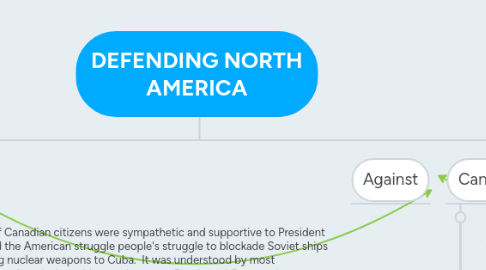
1. Canada's Role in the Cuban Missile Crisis
1.1. Diefenbaker believed it was Kennedy's arrogance that led and endangered North America and could have led to nuclear war. It was no secret that the Prime Minister and the President hated each other during their terms in office.
1.2. Diefenbaker refused to put Canadian troops on alert to DEFCON 3 as Kennedy had requested.
1.3. Diefenbaker only put troops on alert after all other Nato members supported a proposed blockade and agreed to aid the US if an attack occurred. Diefenbaker acted after the crisis climax had passed.
1.4. Prime Minister Diefenbaker first doubted the intelligence he was provided by President Kennedy, and asked ofr more photographs of the missile sites. he also wanted independent U.N. inspectors to go to Cuba and survey for nuclear sites. Kennedy said that there was no time for this.
2. Against
2.1. 15,000 Avro employees lost their jobs abruptly and another 15,000 people in the aeropspace supply chain industry lost their jobs in the near term due to the Arvo Arrow cancellation.
2.1.1. The United States military certainly didn't expect the Arrow program to be scrapped, and more importantly it didn't want the Avro Arrow and its designs to fall into the wrong hands. Interestingly enough, there is strong evidence now to show that blue prints and one prototype Arrow did survive scrapping and did find its way into the US military. The Arrow (CF-105) uncanny similarity to US jets of the decades to come, the F-16 and especially the F-18 demonstrate the high likihood that the US took designs and technologies from the Arrow and incorporated them into their own jets.
2.1.1.1. The Avro Arrow had come to symbolize both the potential and unfulfilled promise of Canadian innovation. As a result its scrapping, it totally devated the Canadian aeorspace industry.
2.1.1.1.1. Many of the scientists and engineers of Avro Canada went on to work for NASA in the years following the scrapping the Arrow program demonstrating the cutting edge technology that Canada and a great loss in this area for our nation.
3. For
4. The Scrapping of the Avro Arrow
4.1. Diefenbaker claimed that the Avro Arrow CF-105) was too expensive and was no longer worth the money. The Avro company was going through millions of taxpayer dollars--400 million and counting, and still the weapons were not decided on. It was estimated it would cost about one billion, a huge amount of money for the late 1950s.
4.1.1. The Avro Arrow was designed as a long-range interceptor of Soviet bombers carrying nuclear war-heads. However, just when the Arrow was rolling into production there was a huge shift from long range bombers to intercontinental ballistic missiles. In the late 1950s the Soviets successfully launched the Sputnik satellite which demonstrated the technology of long range rockets and their potential to carry nuclear war-heads.
4.1.1.1. The RCMP confirmed that a Soviet "mole"had infiltrated the Avro Canada company and was about to smuggle out the blue prints of the Arrow. It was decided by the government in the interest of security to destroy the planes and the blue prints immediately.
4.1.1.1.1. It was hoped that the enormous cost overuns of the Avro Arrow would be offset by selling the planes to Allied nations, like the United States, England and France. However, there was no interest. Because of the enormous size of these jets and their single purpose of shooting down bombers, they did not suit the purpose of European air forces. The Avro Arrow wasn't even designed to carry a gun to shoot down enemy fighters, only missiles.
4.1.1.2. THE ARROW, James Dow, J. Lorimer press, 1979: the definitive work. FALL OF AN ARROW, Murray Peden, Canada's Wings, 1978. SHUTTING DOWN THE NATIONAL DREAM, Greig Stewart, McGraw-Hill Ryerson, 1988. THERE NEVER WAS AN ARROW, E.K. Shaw, Steel Rail Educational, 1981.
